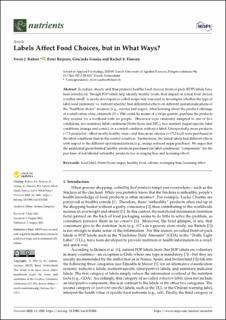Bitte benutzen Sie diese Kennung, um auf die Ressource zu verweisen:
https://doi.org/10.21256/zhaw-25933| Publikationstyp: | Beitrag in wissenschaftlicher Zeitschrift |
| Art der Begutachtung: | Peer review (Publikation) |
| Titel: | Labels affect food choices, but in what ways? |
| Autor/-in: | Kühne, Swen J. Reijnen, Ester Granja, Gracinda Hansen, Rachel S. |
| et. al: | No |
| DOI: | 10.3390/nu14153204 10.21256/zhaw-25933 |
| Erschienen in: | Nutrients |
| Band(Heft): | 14 |
| Heft: | 15 |
| Seite(n): | 3204 |
| Erscheinungsdatum: | 2022 |
| Verlag / Hrsg. Institution: | MDPI |
| ISSN: | 2072-6643 |
| Sprache: | Englisch |
| Schlagwörter: | Food label; Nutri-Score; Sugar; Healthy food; Calorie; Averaging bias; Licensing effect |
| Fachgebiet (DDC): | 150: Psychologie 613.2: Diätetik |
| Zusammenfassung: | To reduce obesity and thus promote healthy food choices, front-of-pack (FOP) labels have been introduced. Though FOP labels help identify healthy foods, their impact on actual food choices is rather small. A newly developed so-called swipe task was used to investigate whether the type of label used (summary vs. nutrient-specific) had differential effects on different operationalizations of the “healthier choice” measure (e.g., calories and sugar). After learning about the product offerings of a small online store, observers (N = 354) could, by means of a swipe gesture, purchase the products they needed for a weekend with six people. Observers were randomly assigned to one of five conditions, two summary label conditions (Nutri-Score and HFL), two nutrient (sugar)-specific label conditions (manga and comic), or a control condition without a label. Unexpectedly, more products (+7.3 products)—albeit mostly healthy ones—and thus more calories (+1732 kcal) were purchased in the label conditions than in the control condition. Furthermore, the tested labels had different effects with respect to the different operationalizations (e.g., manga reduced sugar purchase). We argue that the additional green-labeled healthy products purchased (in label conditions) “compensate” for the purchase of red-labeled unhealthy products (see averaging bias and licensing effect). |
| URI: | https://digitalcollection.zhaw.ch/handle/11475/25933 |
| Volltext Version: | Publizierte Version |
| Lizenz (gemäss Verlagsvertrag): | CC BY 4.0: Namensnennung 4.0 International |
| Departement: | Angewandte Psychologie |
| Organisationseinheit: | Psychologisches Institut (PI) |
| Enthalten in den Sammlungen: | Publikationen Angewandte Psychologie |
Dateien zu dieser Ressource:
| Datei | Beschreibung | Größe | Format | |
|---|---|---|---|---|
| 2022_Kuehne-etal_Labels-affect-food-choices_nutrients.pdf | 2.71 MB | Adobe PDF |  Öffnen/Anzeigen |
Zur Langanzeige
Kühne, S. J., Reijnen, E., Granja, G., & Hansen, R. S. (2022). Labels affect food choices, but in what ways? Nutrients, 14(15), 3204. https://doi.org/10.3390/nu14153204
Kühne, S.J. et al. (2022) ‘Labels affect food choices, but in what ways?’, Nutrients, 14(15), p. 3204. Available at: https://doi.org/10.3390/nu14153204.
S. J. Kühne, E. Reijnen, G. Granja, and R. S. Hansen, “Labels affect food choices, but in what ways?,” Nutrients, vol. 14, no. 15, p. 3204, 2022, doi: 10.3390/nu14153204.
KÜHNE, Swen J., Ester REIJNEN, Gracinda GRANJA und Rachel S. HANSEN, 2022. Labels affect food choices, but in what ways? Nutrients. 2022. Bd. 14, Nr. 15, S. 3204. DOI 10.3390/nu14153204
Kühne, Swen J., Ester Reijnen, Gracinda Granja, and Rachel S. Hansen. 2022. “Labels Affect Food Choices, but in What Ways?” Nutrients 14 (15): 3204. https://doi.org/10.3390/nu14153204.
Kühne, Swen J., et al. “Labels Affect Food Choices, but in What Ways?” Nutrients, vol. 14, no. 15, 2022, p. 3204, https://doi.org/10.3390/nu14153204.
Alle Ressourcen in diesem Repository sind urheberrechtlich geschützt, soweit nicht anderweitig angezeigt.